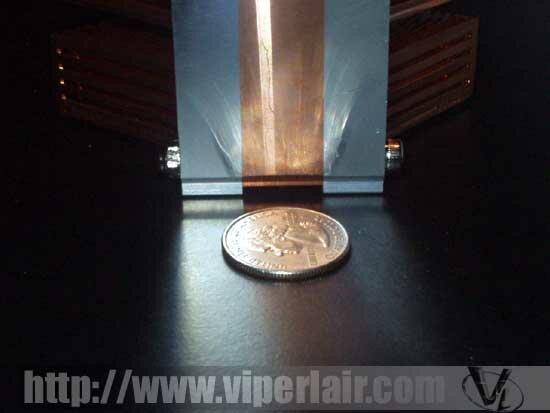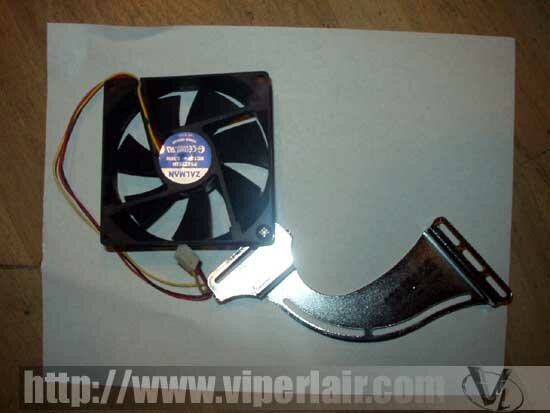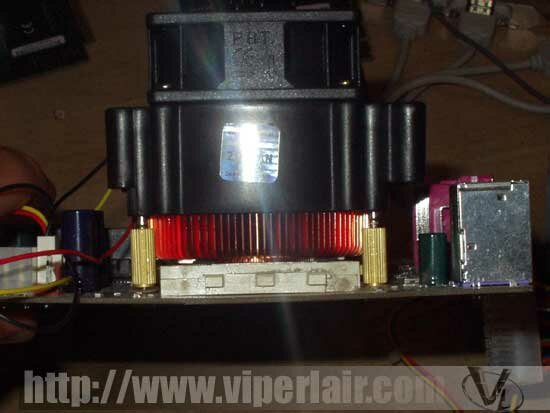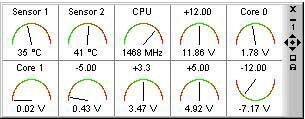With the AMD CPU becoming ever more popular, and Intel's CPU's also increasing their heat output, CPU cooling has reached it's peak in competitiveness between companies. The most common method utilized in today's computers is active cooling - cooling with air - but with more airflow, there is more noise. The (based in Korea) has presented an onslaught of exotic-looking coolers that all conform to the CNPS (Computer Noise Prevention System) and try to make your computer quieter. But will changing a fan or two here and there really work?
The CNPS3100-Plus
The first of the two coolers that Zalman sent me is the CNPS3100-Plus. It uses their trademark "flower" design - the theory behind this heatsink is that the large amount of surface area will cause heat dissipation to be quicker than that of a traditional copper heatsink. Due to the unique shape of the heatsink, there is no fan mounted to it. Zalman has a 92mm fan and a fan bracket which is installed on top of the metal brackets for your PCI and AGP cards. This solution (in my opinion) was a very interesting way to get a fan on top of the cooler. The bottom is finished and shined to perfection.

Part Number: ZM6548BC-Cu
HSF Dimensions: Approximately 105x52x65 mm
Dissipation Area: 2000cm2
Base Material: Pure Copper
Mass: 296 g

The fan runs at about 1600 RPMs in silent mode, and 2800 RPMs in normal mode. The different modes are dictated by plugging the molex connector for the fan into the "silent" connector which Zalman supplies (simply has a resistor to lower the voltage.) The normal mode is achieved by directly plugging the 92 mm fan into the power supply.

This allows you to slow down the fan to reduce noise

The Fan and Bracket for the CNPS3100-Plus
Each mode has it's own capabilities - for AMD processors:
In silent mode , all Durons are supported, as well as T-Birds up to 1.4Ghz, AthlonXP's up to 1800+ and AthlonXP T-bred up to 2600+.
In normal mode, all Durons, T-Birds, and XP's up to and over 2600+ are supported.
Included in the package is the 92 mm fan with bracket, as well as the clip with it's mate (more on this convenient design later) as well as the RC56 (fan speed reduction) and thermal grease.




The Zalman clip allows for easy clip installation without those cut motherboard leads
The clip is special in that I have never seen any with the clip mate capability. There is a small hole on the top of the clip which allows you to insert a "clip mate" and use that to push down the clip, thereby eliminating the possibility of slipping and cutting a small lead. This design worked quite well and Zalman should be commended for looking out for the user's motherboard.
The CNPS5100-Cu

The second HSF that Zalman sent was the CNPS5100-Cu. Its design once again is unique in its construction - round and in a way, yet flower-like. The CNPS5100 (due to its weight) mounts to the motherboard, allowing for a more secure mount.

The heatsink needs to be mounted due to its weight
The 60 mm fan is louder than the 92 mm (compared high speed to high speed) so a "fan mate" is included, which is pretty much just a variable resistor hooked up to a knob - but it works well. The mounts on the motherboard are separated by cardboard washers which are included.

This Fan-Mate and accessories come with the CNPS5100-Cu
Part Number: ZM4360EE-Cu
HSF Dimensions: Approximately 90x66x70 mm
Dissipation Area: 1500 cm2
Base Material: Pure Copper
Mass: 344

This cooler is certified for all current CPUs.
One of the things that stood out about this cooler was its weight. The cooler weighs 344g which is actually 44 grams above the AMD heatsink mass specification. Evidently, the motherboard mounting is necessary on an AMD machine.
The cooler comes with:
Bolts for AMD and Intel CPU's
Four Spacers
Four springs (for the bolts, so they remain secure)
Washers for different motherboard (between the motherboard and the metal bolts)
Thermal Grease
Adjustable Fan Speed Controller (Fan Mate)
Both models came with all their necessary components, as well as instructions for installation which were very competent.
For testing, our comparison cooler is the Vantec 6027D.
The ZM300A-APF
The final item which Zalman sent me was the ZM300A-APF - a 300 Watt CNPS PSU (Power Supply Unit.) There is a thermistor (essentially a resistor which responds to heat,) which is attached to the heatsink in the PSU. To be honest, when first looking at this PSU I had many doubts - 300 Watts really isn't a lot of power - especially when you're running not only an Athlon, but also numerous other devices. It's not exactly the easiest thing to review a PSU, but what I found was that for a 300 watt PSU, it had a supreme advantage to my "stock" 300 Watt PSU.

What's included with the PSU
The PSU comes with a Multi-Connector (to connect your Zalman fans to,) as well as a power cable, and naitive voltage recognition - there's no switch on the back to change from 120V to 230V.
The plethora (7 Molex) of connectors was more than sufficient for all of my devices and then some. I found that with my old 300 Watt PSU, there was a + or - 1.5V on each line, which varied higher and lower - in an unstable fashion, as well as only 5 molex connectors.

This stock 300 Watt PSU leaves something to be desired, especially with only 5 molex connectors
Performance
My Machine:
CPU: Athlon 1700+ with Arctic Silver 3
Motherboard: Abit KR7A-Raid - socket thermistor touching the bottom of the CPU
Case: Fong-Kai 320-Black, 1 case fan running
Prime95 run for 20 minutes, Room Temperature is 22 degrees Celcius
Comparison Cooler: Vantec CCK-6027D
Before we look at performance, let's see if this so called "CNPS" works - if the Computer Noise Prevention System isn't just a gimmick.
The Deafness Research Foundation (http://www.drf.org) provides the following information:
Decibel Level Example
30: Quiet Library, soft whispers
40: Living room, refrigerator, bedroom away from traffic
50: Light traffic, normal conversation, quiet office
60: Air conditioner at 20 feet, sewing machine
70: Vacuum cleaner, hair dryer, noisy restaurant
80: Average city traffic, garbage disposals, alarm clock at two feet
THE FOLLOWING NOISES CAN BE DANGEROUS UNDER CONSTANT EXPOSURE!
90: Subway, motorcycle, truck traffic, lawn mower
100: Garbage truck, chain saw, pneumatic drill
120: Rock band concert in front of speakers, thunderclap
140: Gunshot blast, jet plane
180: Rocket launching pad
They say that at 120 db (Decibels) hearing loss occurs after 9 seconds, and at 96 dB, hearing loss occurs after 37 minutes.
The question becomes for me - how do I measure these while at the same time preventing excess noise from being registered, as well as the air from a fan blowing across the microphone and giving it a false reading. I held the Sound Level Meter (Analog - purchased at Radio Shack, CAT. NO. 33-2050, Weighting set to "C", Response set to "Fast".) The sound level meter was placed approximately 2 inches away (perpendicularly) to the fan as to reduce the possibility of the airflow causing a discrepancy. Please note that these values are much louder than what you would hear when a case is all closed up.
The CNPS3100-Plus (when it's fan resistor was removed) registered at 66 dBs
The CNPS5100-Cu (without the Fan-Mate) registered at 72 dBs
The comparison cooler (Global Win delta-style fan) registered at 81 dBs
We can see here that the coolers registered in between an Air Conditioner or Sewing Machine and Average city traffic. Once again, take into consideration that a case will muffle the sound.
Now let's see how these stack up performance wise...
The room was kept at a constant 22 degrees Celsius; the motherboard registered the case temperature at 35 degrees Celsius. We'll first be demonstrating the comparitive temperatures of low and high speed fan settings for the CNPS5100-Cu.
Idle Temperatures (degrees Celsius)

Load Temperatures (degrees Celsius)

With the fan at its highest speed on the Fan-Mate, the CNPS5100-Cu had:
An idle of 39 Degrees C
After the Prime95 test, the CPU was at 45 Degrees C
With the fan turned to its lowest point, the CNPS5100-Cu had:
An idle of 45 degrees
After the Prime95 test, the CPU was at 52 Degrees C
I found that with the resistor on the fan included with the CNPS3100-Plus, the temperatures were not comparable to those obtained by the other coolers, so only the temperatures with the fan set to its highest RPM have been recorded.
Idle Temperatures (degrees Celsius)

Load Temperatures (degrees Celsius)

The CNPS3100-Plus had:
An idle of 52 Degrees C
After the Prime95 test, the CPU was at 58 Degrees C
The CCK-6072D had:
An idle of 39 Degrees C
After the Prime95 test, the CPU was 43 Degrees C
ZM300A-APF Tests
The ZM300A-APF is compatible with both Athlons and Pentium 4 motherboards, as it has the necessary auxiliary connectors needed.
The noise generated at high load was approximately 40 dBs.

The Zalman ZM300A-APF 300Watt PSU is quiet and stable
On the other hand, this PSU has been very good in its stability - I have not noticed a very large change in voltage on any of the lines - only noticing that there was a 0.5V difference on the 5V line under extreme stress.
Final Words
The power supply may be borderline for most power users, but it is a quality PSU. Enthusiasts should probably opt for a 400W model though, as multiple hard drives, high end CPUs and blazing video cards will put a strain on lesser PSUs.
As for the coolers, they work well enough, though the CNPS3100-Plus may not be the best choice for overclockers. Both heatsinks are remarkably quiet, and this is something that is gaining popularity for a lot of users tired of the noise. To see how they stack up, here's a chart summary of the two coolers compared with the Vantec...

Overall, I have found Zalman to be an extremely high quality company. Their products show thought in their design - and innovation.
CNPS3100-Plus:
Pros: Exotic design, very quiet
Cons: It won't keep your processor all that cool
CNPS5100-Cu:
Pros: This bad-boy stacks up with the Vantec, and is more secure with its motherboard mounts
Cons: The extra 44 grams of weight might just be enough for the novice to crack their die.
ZM300A-APF:
Pros: For 300 Watts, this PSU is a sure-buy
Cons: None



